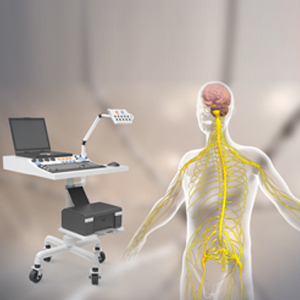Electromyography (EMG) /Nerve Conductions Studies (Electrodiagnostic Medicine)

Numbness, tingling, pain, weakness, and loss of muscle bulk may indicate a nerve impingement or a nerve irritation. While x-rays, CT scans, and MRI scans are useful in producing a picture that you doctor can use to infer the possibility of a nerve impingement or a nerve irritation. These tests do not actually demonstrate what is actually going on with the nerve itself. In addition, x-rays, CT scans, and MRI scans are often non-specific and may demonstrate multiple abnormal findings, each of which may be capable of being the source of numbness, tingling, pain, weakness, and loss of muscle bulk. EMG/NCS is a useful test that can be used to complement the information obtained in a history, the physical examination, and tests. Conditions commonly diagnosed with the use of EMG/NCS include carpal tunnel syndrome, cervical radiculopathy (nerve root impingement or irritation in the neck), and lumbar radiculopathy (nerve root impingement or irritation in the lower back).
WHAT IS AN EMG/NCS?
Electromyography (EMG) involves a very thin needle or wire electrode that is placed into your muscle. By observing the activity on the screen as well as listening to the activity, this test is used to detect current or past irritation or impingement of the nerve, a problem with the nerve to muscle junction, or a problem with the muscle itself.
Nerve Conduction Study (NCS) involves small shocks using a stimulating electrode and measured by recording electrodes. This test measures how quickly the motor and sensory nerves are conducting messages from one point to another.
This procedure is performed by a physician trained in electro-diagnostic medicine. Several PSSP physicians have achieved expertise in this procedure.
RISKS AND SIDE EFFECTS
There are no risks associated with nerve conduction studies. Nothing is inserted into the skin, so there is no risk of infection. The voltage of electrical pulses is not high enough to cause an injury or permanent damage. There is a theoretical risk that if you have a cardiac defibrillator, the shock from the nerve conduction study may activate it. If you have a cardiac defibrillator or a pacemaker, notify us before the examination.
Electromyography (EMG) is very safe. With the EMG, you may develop small bruises or swelling at some of the needle insertion sites. Please notify us if you are on a blood thinner or have a bleeding disorder. The skin is sterilized with alcohol pads, and sterile, single-use, prepackaged wire electrodes are used and discarded after each and every examination, so infections are extremely rare.
PRE AND POST PROCEDURE INSTRUCTIONS
Pre EMG-Instructions
- You may drive to and from the testing.
- There are no restrictions in regard to your eating or activity before or after the testing.
- You may take your usual medications. Please give the physician performing your examination a list of medications you are currently taking.
- Please take off your jewelry and watches and secure them in your clothing or bag.
- It is advisable to BATHE, SHOWER or SPONGE BATHE prior to the procedure. If possible, use mild soap only.
- Do not apply any lotion or ointments on your skin on the day of testing.
Post EMG/NCS Instructions
During the test, the physician will mark on your skin with a ballpoint pen to facilitate measurements. The ink wipes off easily with alcohol pads. You may ask the physician for some alcohol pads after conclusion of the examination.
You may feel some mild soreness following the examination. Should this occur, the best way to address this is to use ice over the affected area for up to 10 minutes at a time. You may repeat this every hour. Do not do this, however, if you have diabetes or have peripheral blood vessel disease. Even if you do nothing, the soreness or bruising will resolve spontaneously and completely within a few days.
Remember, this test is meant to help you and to give you answers. If you have any questions, feel free to ask the physician performing the test.
